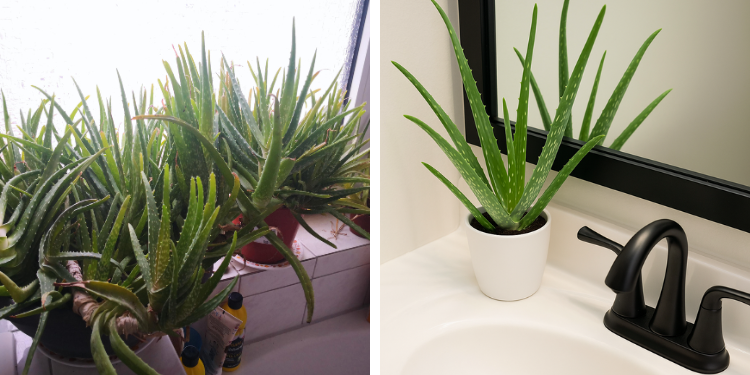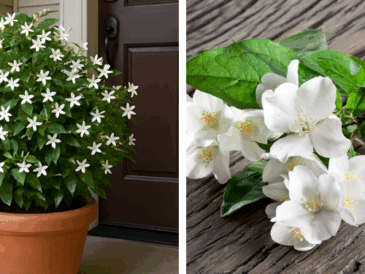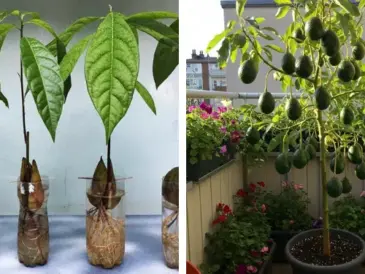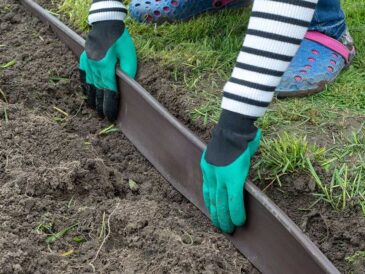If there’s one plant that deserves a permanent place in every home – especially in your bathroom – it’s Aloe vera.
Known as the “plant of immortality” in ancient Egypt, Aloe vera is far more than just a pretty succulent.
Its soothing gel is packed with nutrients, its air-purifying ability rivals that of a mechanical filter, and its resilience makes it nearly impossible to kill – even for beginners.
But there’s something truly special about keeping Aloe vera in the bathroom. The warmth, humidity, and indirect light create the perfect mini oasis where this healing plant thrives while enhancing your well-being in countless ways.
1. Aloe Vera Thrives in Bathroom Conditions
Bathrooms may seem like an unusual place for plants, but Aloe vera loves it there.
Unlike most succulents that prefer dry air, Aloe vera can adapt to humid environments surprisingly well – especially when it receives bright, indirect light from a window.
Here’s why your bathroom is the perfect microclimate:
- Humidity from showers keeps the plant hydrated without overwatering.
- Warm temperatures mimic Aloe’s natural desert habitat.
- Filtered light from frosted windows prevents leaf scorching.
- Compact size makes it ideal for countertops, shelves, or window sills.
This natural adaptability means even busy homeowners or apartment dwellers can keep Aloe happy year-round without much effort.
Just be sure the pot has good drainage holes and avoid placing the plant where water splashes directly on it (like near the shower or sink).
Pro tip: Bathrooms with south- or west-facing windows are perfect. If your bathroom has no window, move the Aloe to a bright spot every few days to recharge under natural light.
2. It Purifies and Freshens the Air Naturally
Bathrooms often trap humidity, odors, and airborne chemicals from cleaning products, soaps, and deodorants.
Over time, these compounds – especially formaldehyde, ammonia, and benzene – can linger in the air and irritate your lungs or skin.
Aloe vera helps solve that problem naturally.
How it works:
- Its thick, fleshy leaves absorb harmful airborne toxins through tiny pores.
- The plant releases oxygen at night, improving air quality even while you sleep.
- It subtly neutralizes odors, leaving your bathroom smelling fresher and cleaner.
In fact, NASA’s Clean Air Study ranked Aloe vera among the top plants for removing toxins and purifying indoor air.
Unlike artificial air fresheners that mask smells, Aloe works silently and continuously – making your bathroom a healthier, fresher place to unwind.
3. An Instant First-Aid Kit on Your Counter
Few plants are as practical to keep nearby as Aloe vera. Its soothing gel is a natural miracle for skin, making it a quick and effective remedy for everyday bathroom mishaps.
Here’s what Aloe’s clear gel can do:
- Soothe burns: Perfect for calming minor burns or steam irritation.
- Heal razor cuts and nicks: Aloe’s antibacterial properties help disinfect and speed up healing.
- Moisturize dry hands: After washing, apply a small amount for soft, non-greasy hydration.
- Calm shaving irritation: Use as an aftershave to reduce redness and bumps.
- Soothe insect bites: The cooling gel reduces itching and swelling.
Keeping Aloe in the bathroom means you can snip a leaf and apply the gel immediately, taking advantage of its freshest and most potent healing compounds.
How to use Aloe gel:
- Cut a mature outer leaf near the base.
- Slice it open lengthwise.
- Scoop out the clear gel with a spoon.
- Apply directly to the affected area.
Store leftover gel in the fridge for up to a week – or apply the leaf directly for maximum freshness.
Pro tip: Avoid bottled Aloe gels that contain additives or alcohol. Fresh from the plant is always more effective and soothing.
4. Adds Green Beauty and Calm to Your Bathroom
Bathrooms are often sterile or plain spaces filled with tile, glass, and metal. A touch of greenery instantly softens that look – creating a spa-like atmosphere that feels calming and restorative.
Aloe vera’s sculptural form and vibrant green color make it a natural fit for modern, minimalist, or rustic bathrooms.
The aesthetic benefits:
- Its upright, architectural leaves add texture and structure.
- The lush green tone contrasts beautifully with white or neutral tiles.
- It visually connects indoor spaces to nature, promoting relaxation.
Studies in environmental psychology show that even a small amount of greenery can reduce stress, lower blood pressure, and improve mood – making your daily routine feel more like self-care.
Whether placed near the bathtub, on a vanity shelf, or beside the window, Aloe vera brings a touch of tranquil, natural elegance to your morning and evening rituals.
5. A Natural Humidity Regulator
Another underrated reason to keep Aloe in the bathroom is its ability to balance humidity levels naturally.
Because Aloe vera stores water in its thick leaves, it subtly interacts with the moisture in the air – absorbing or releasing it as needed.
Benefits include:
- Preventing mildew and musty odors: By stabilizing humidity, Aloe helps reduce mold growth on tiles and grout.
- Protecting wood surfaces: If your bathroom has wooden shelves or cabinets, the plant helps buffer against excessive dampness.
- Improving comfort: Proper humidity makes the air feel fresher and more breathable.
A single medium-sized Aloe plant won’t replace a dehumidifier, but combined with good ventilation, it makes a noticeable difference – especially in smaller bathrooms that tend to trap steam.
6. Easy to Care For – Even for Beginners
If you’ve ever struggled to keep houseplants alive, Aloe vera might be your perfect match. It’s one of the most forgiving and low-maintenance plants you can grow indoors.
Basic care guide for bathroom Aloe vera:
Light:
- Prefers bright, indirect light.
- Can tolerate occasional direct sunlight but avoid prolonged exposure that scorches the leaves.
- In low-light bathrooms, move it to a sunny window once a week.
Watering:
- Water deeply but only when the soil is completely dry (usually every 2–3 weeks).
- Drain excess water immediately to prevent root rot.
- In winter, reduce watering to once a month.
Soil:
- Use a cactus or succulent mix for fast drainage.
- Avoid heavy or compact soil – Aloe roots need airflow.
Temperature:
- Ideal range: 60–80°F (15–27°C).
- Protect from drafts or cold air near windows.
Fertilizer: Feed sparingly – once every 6–8 weeks during spring and summer with a diluted liquid fertilizer.
If cared for properly, Aloe vera can live for 10 years or more, growing into a beautiful, mature plant that continually produces new “pups” (baby plants) for propagation.
Propagation tip:
- Remove the small offshoots from the base, let them dry for a day, then plant them in small pots.
- Soon, you’ll have more Aloe plants to place around your home or give as thoughtful, healing gifts.
Bonus: Aloe Vera Supports Sustainable Living
Keeping Aloe vera in your bathroom aligns beautifully with an eco-friendly lifestyle.
Instead of reaching for chemical lotions, conditioners, or first-aid products, you can often use Aloe directly from the plant as a pure, zero-waste alternative.
The Healing Power of Aloe: Backed by Science
Modern research confirms what ancient civilizations already knew – Aloe vera is a potent medicinal plant with impressive therapeutic properties.
Scientifically proven benefits include:
- Anti-inflammatory: Calms irritated skin and reduces redness.
- Antibacterial and antifungal: Helps prevent infection in minor cuts and burns.
- Hydrating: Locks in moisture without clogging pores.
- Antioxidant-rich: Neutralizes free radicals that cause premature skin aging.
- Wound-healing: Stimulates fibroblast activity to repair tissue faster.
This makes Aloe not only a lovely addition to your bathroom decor but also a functional plant for wellness and skincare.
From soothing sunburns to treating acne and eczema, it’s a versatile ally in your everyday health routine.
Common Questions About Keeping Aloe in the Bathroom
1. Can Aloe vera survive in low light?
Aloe needs some indirect light to stay healthy. If your bathroom has no windows, rotate it to a sunny area once a week or use a small grow light.
2. Should I mist my Aloe?
No. Aloe stores water in its leaves and doesn’t need misting. Too much moisture on the leaves can encourage mold in humid bathrooms.
3. What’s the best container for Aloe vera?
Choose a terracotta or clay pot with a drainage hole. These materials allow air circulation and prevent root rot.
4. My Aloe leaves look thin and droopy – what’s wrong?
That’s usually a sign of overwatering or insufficient light. Let the soil dry completely and move it closer to a light source.
5. Can I keep other succulents in the bathroom too?
Yes! Jade plants, snake plants, and haworthias also adapt well to humid, indirect-light conditions. Pair them with Aloe for a soothing mini indoor garden.
From healing skin irritations to cleaning the air and beautifying your space, Aloe vera truly earns its title as the ultimate bathroom plant.




